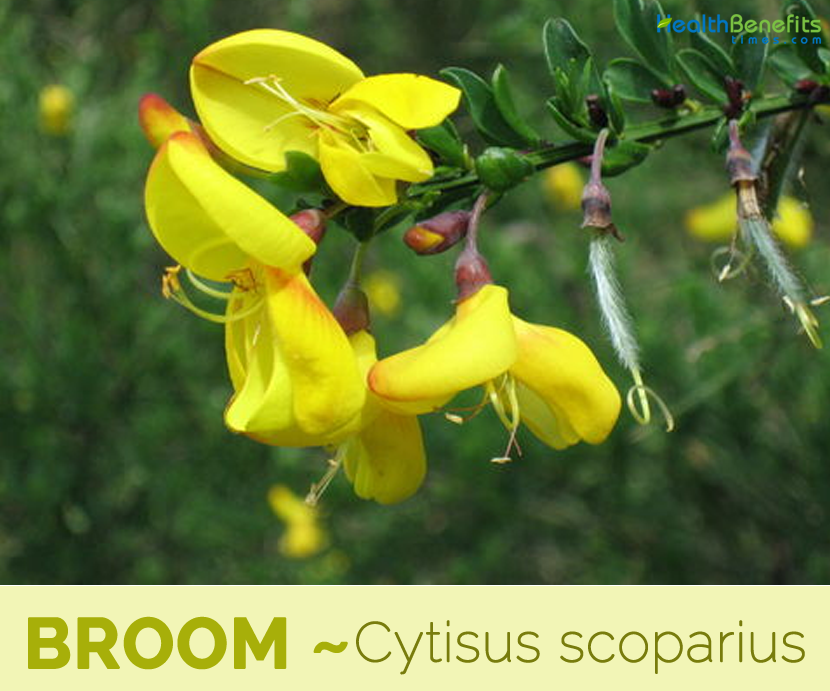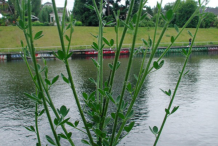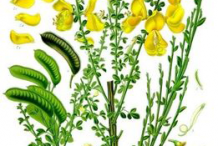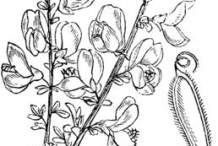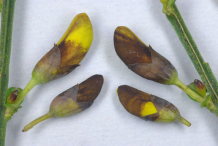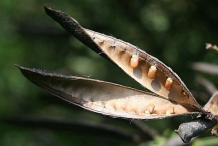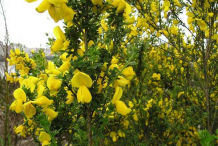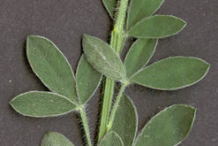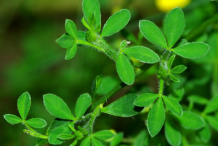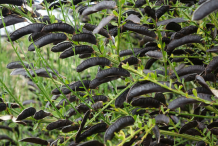Plant Description
Broom is a multi-stemmed, deciduous/evergreen, erect and bushy shrub that grows about 6 to 12 feet (2-4 m) tall. They are found growing in disturbed areas, open forests, roadsides, grasslands, pastures, cultivated fields, wasteland, dry meadows, dry riverbeds and other waterways, sandy pastures and often near the coast. It prefers moderately fertile, dry to medium, well-drained soils. It can also tolerates poor rocky soils (good bank cover), but avoid wet soils. It has taproot that may exceed 2 feet in length with large, shallow lateral roots. Stem is hairy when young and glabrous as they mature. Branches are numerous long, straight, slender bright green branches, tough and very flexible, smooth and prominently angled.
Roots
The broom plants form deep, branched taproots with fine roots associated with nitrogen fixation. New shoots can grow from the crown when plants are cut above the crown.
Leaves
Leaves of broom are alternate and compound consisting of three oblong leaflets. Very few leaves are present on stems. New twigs may only have one leaflet. Leaflets are small approximately 0.3 to 0.7 inch (5-20 mm) long and 1.5 to 8 mm wide. The leaflets are dark green and fleshy and serrated along their margin. The underside of the leaflets is covered by flattened, short hairs while the upper surface is smooth.
Flowers
Flowers are pea-like; upper and lower curved petal has wing petals on each side. Scotch broom flowers are yellow to partially to complete red in color. They are small, only 1-2.5 cm. The stamens are fused. Plants flower from May to June.
Fruits
Fruits develop as seed pods that mature in June-July. Seed pods are 2.5-7 cm long and 8-13 mm wide, smooth with long silky hairs. Pods are initially green which turn dark brown to black when mature. Seeds are small, 3-4 mm diameter long and shiny, brown to black in color with a whitish appendage which attracts ants and some birds. Nearly 3-12 seeds are found within each pod.
History
Scotch broom originates from Europe. It was brought to North America as an ornamental garden plant in the 1800s. It also had other uses, including: a coffee alternative, medicinal uses, and a source of yellow dye. Since then it has managed to escape from many gardens and is a common invader on both the Pacific and Atlantic coasts. In PEI there have been a few sightings of scotch broom along roadsides and in ditches. However, most are contained in gardens.
Varieties
There are two subspecies, which differ mainly in growth habit:
1. Cytisus scoparius subsp. scoparius (Common Broom)
An erect shrub, growing to 2-3 meters (rarely 4 m) tall; shoots thinly hairy at first, soon becoming glabrous. This is the common form, occurring through most of the species range.
2. Cytisus scoparius subsp. maritimus (Rouy) Heywood (Prostrate Broom)
Prostrate, ground-hugging shrub, not exceeding half a meter in height; shoots densely silky-hairy. It is restricted to the Atlantic coasts of southern Ireland, west Wales, southwestern England, and northwestern France.
Traditional uses and benefits of broom
- Blossoms were used for making an ointment to cure the gout.
- Henry VIII used to drink water made from the flowers against the surfeit.
- Dodoens recommended a decoction of the tops in dropsy and for ‘stoppages of the liver.’
- Culpepper considered the decoction of Broom to be good not only for dropsy, but also for black jaundice, ague, gout, sciatica and various pains of the hips and joints.
- Tablespoonful of powdered seeds in a glass of peppermint water was taken daily for liver complaints and ague.
- Compound decoction of Broom is recommended in herbal medicine as of much benefit in bladder and kidney affections, as well as in chronic dropsy.
- Broom is a bitter narcotic herb that reduces the respiration and regulates heart action.
- It acts upon the electrical conductivity of the heart, slowing and regulating the transmission of the impulses.
- Young herbaceous tips of flowering shoots are cardio-tonic, cathartic, diuretic, emetic and vasoconstrictor.
- Plant is used internally in the treatment of heart complaints, and is especially used in conjunction with Convallaria majalis.
- Plant is also strongly diuretic, stimulating urine production and thus countering fluid retention.
- Broom causes the muscles of the uterus to contract; it has been used to prevent blood loss after childbirth.
- It is used as remedy for treating an irregular and fast heart beat rate.
- The herb slows down and controls the transmission of the nerve impulses in cardiac muscles.
- The broom helps stimulate the production of urine and counters fluid retention in the body.
- Together with lily of the valley, the broom herb is employed internally for treating problems related to the heart.
- Broom is applied to the skin for sore muscles, pockets of infection (abscesses), and swelling.
- Broom is also used in hair rinses to lighten and brighten hair.
Dosing
Adults (18 years and older)
It is not clear what dose(s) of scotch broom are safe or effective for any medical condition, and use should only be under medical supervision. Storage of the flower or herb should be in a cool, dry location.
A juice has been made by pressing the bruised, fresh tops and adding one-third volume alcohol, allowing it to sit for seven days, followed by filtration, and taken daily as needed. An infusion has been made by adding 1 ounce of dried tops to a pint of boiling water (or 1 teaspoon in 200 milliliters boiling water) and taken as a cup-full once or twice daily as needed.
As a tea, 1-2 grams (1 level teaspoon) of herb can be steeped in 150-200 milliters of boiling water, then strained after 5-10 minutes and taken as a cup-full, up to three times daily as needed. As a decoction, 1-2 grams of herb have been used in preparations. As a liquid extract, a 1:1 preparation in 25% ethanol (v/v) has been prepared and taken as 1-2 milliliters as needed. As a tincture, a 1:5 preparation in 45% ethanol (v/v) has been taken at a dose of 0.5-2 milliliters daily. The herb may also be available as an aqueous-ethanol preparation (1:1:5) or as an aqueous essential oil extract.
Children (younger than 18 years)
Avoid due to potentially life-threatening toxicity.
Culinary uses
- Tender plant tops have been used to flavor beer.
- Leaves and aged flowers have been smoked to produce euphoria.
- Roasted Seeds are served as a substitute for coffee.
- The flower buds are pickled and used as a substitute for capers.
- Flower buds of this plant may be included in salads.
Other Facts
- It is often used as an outdoor ornamental to hold steep, barren banks in place.
- Moldy, dried blossoms are pulverized, rolled in cigarette paper and smoked like marijuana.
- Tannin exists in considerable amount in the bark, which has been used in former times for tanning leather.
- Green tops were a good winter food for sheep, preventing rot and dropsy in them.
- An excellent fiber is obtained from the bark; it is used in the manufacture of paper, cloth and nets.
- Yellow and a brown dye are obtained from the bark.
- Yellow dye is obtained from the flowering stem.
- Green dye is obtained from the leaves and young tops.
- Branches are used to make baskets, brushes, brooms and besoms.
- They are also sometimes used for thatching roofs and as substitutes for reeds in making fences or screens.
- An essential oil from the flowers is used in perfumery.
- Broom can produce up to 10.000 seed per season.
- Broom can be used to prevent erosion of the soil.
- Leaves or young tops yield a green dye.
Precaution
- Avoid use during pregnancy and breast feeding.
- Excess use may cause Nausea and Diarrhea.
- Use this herb with caution since large doses are likely to upset the stomach.
- This herb should not be prescribed for patients with high blood pressure, kidney disorders, spleen disorders as well as liver disorders.
- Seeds of Scotch broom are toxic for humans and livestock.
References:
https://plants.usda.gov/core/profile?symbol=cysc4
https://www.itis.gov/servlet/SingleRpt/SingleRpt?search_topic=TSN&search_value=501966#null
http://davesgarden.com/guides/pf/go/31424/
http://www.hear.org/pier/species/cytisus_scoparius.htm
https://www.drugs.com/npp/broom.html
http://www.botanical.com/botanical/mgmh/b/broom-70.html
https://npgsweb.ars-grin.gov/gringlobal/taxonomydetail.aspx?id=13019
http://www.pfaf.org/user/plant.aspx?latinname=Cytisus+scoparius
http://mtweed.org/weeds/scotch-broom/
https://en.wikipedia.org/wiki/Cytisus_scoparius
http://www.cabi.org/isc/datasheet/17610
http://peiinvasives.ca/wp-content/uploads/2011/12/Scotch-Broom.pdf
Comments
| Broom Quick Facts | |
|---|---|
| Name: | Broom |
| Scientific Name: | Cytisus scoparius |
| Origin | Central and southern Europe |
| Colors | Green turning to nearly black when mature |
| Shapes | Oblong pods are 2.5-7 cm long and 8-13 mm wide, dehiscent, strongly compressed, |
| Taste | Sweet |
| Name | Broom |
|---|---|
| Scientific Name | Cytisus scoparius |
| Native | Central and southern Europe |
| Common Names | Scotch Broom, Broomtops, Common Broom, European Broom, Irish Broom, Genista, Broom, Besom, Scoparium, Irish Tops, Basam, Bizzom, Browme, Brum, Breeam |
| Name in Other Languages | Afrikaans: Skotse brem Australia: English broom; Scottish broom Catalan: Gódua Chinese: Jīn qiǎo er (金雀儿), jin que hua (金雀花), jin que er shu Danish: Almindelig Gyvel Denmark: Gyvel Dominican Republic: Citiso; gandulillo Dutch: Brem, Gewone brem English: Broom, Broomtops, Common Broom, English broom, European broom, Irish broom, Scotch broom, scotchbroom, Scots Broom, Scottish broom Finnish: Jänönvihma French: Genêt à balai, Juniesse, Genêt à balais, Genêt à balais commun German: Besenginster, Gemeiner besenginster, besenginaterkraut Irish: Giolcach sléibhe Italian: Ginestra, Ginestra dei carbonai, ginestra scopareccia, amaracciole , emero scornabecco, Netherlands: Bezemstruik; brem Norwegian: Gyvel Portuguese: Giesta, giesteira das vassouras Romanian: Drob, mature Russian: Ракитник венечный, zharkovetz metelchatyi Scottish Gaelic: Bealaidh South Africa: Skotse brem Spanish: Retama negra, escoba negra; retama de escobas, retama Swedish: Har-ris, Harris, gyvel Welsh: Banadl cyffredin |
| Plant Growth Habit | Long-lived, erect, bushy shrub |
| Growing Climate | Invades disturbed areas, open forests, roadsides, grasslands, pastures, cultivated fields, wasteland, dry meadows, dry riverbeds and other waterways, sandy pastures and often near the coast |
| Soil | Moderately fertile, dry to medium, well-drained soils. Tolerates poor rocky soils (good bank cover). Avoid wet soils. |
| Plant Size | 6 to 12 feet (2-4 m) tall |
| Root | Taproot that may exceed 2 feet in length with large, shallow lateral roots |
| Stem | Hairy when young and glabrous as they mature |
| Branch | Numerous long, straight, slender bright green branches, tough and very flexible, smooth and prominently angled |
| Leaf | Alternate, 5-15 mm long, hairy when young the lower ones shortly stalked, with three small, oblong leaflets, the upper ones, near the tips of the branches, sessile and small, often reduced to a single leaflet. |
| Leaflets | Approximately 0.3 to 0.7 inch (5-20 mm) long and 1.5 to 8 mm wide, oval shaped, darker green on the top of the leaf and paler and hairy on the underside of the leaf. |
| Flowering Periods | May to June |
| Flower | Flowers are pedicellate, solitary or in pairs, and borne in the axils on 1-year-old stems. The calyx is glabrous, ca 6 mm long, two-lipped, upper lip with two teeth, lower lip with three teeth, all teeth usually much shorter than the lips. The corolla is golden yellow, 15-25 mm long. |
| Fruit Shape & Size | Oblong pods are 2.5-7 cm long and 8-13 mm wide, dehiscent, strongly compressed, with brown or white hairs on the margin, otherwise glabrous |
| Fruit Color | Green turning to nearly black when mature |
| Taste | Sweet |
| Seed | 3-4 mm diameter |
| Plant Parts Used | Flower, seed |
| Varieties |
|


